Search the Special Collections and Archives Portal
Search Results
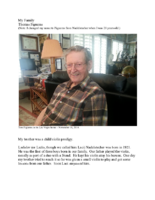
Biographical essay by Tom Figueras, 2014
Date
Archival Collection
Description
Essays by Tom Figueras give details about his brother, Ladizlav or "Laci," who was a prodigy violin player in Germany during the Holocaust, and eventually ended up in a sub-camp of Buchenwald and then in Bergen-Belsen where he perished. Figueras survived the Holocaust, but his parents did not. He came to the United States in 1960 and became a marketing manager for a telecommunications company.
Text
Audio clips from interview with Maurice "Maury" Halfon Behar, March 14, 2016
Date
Archival Collection
Description
In clip 1, Maury Behar discusses how he survived the Holocaust. In clip 2, he discusses how he came to live in Las Vegas, Nevada.
Sound
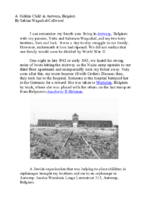
Biographical essay by Sabina Callwood, 2014
Date
Archival Collection
Description
Essays describe Sabina Callwood's experience during the Holocaust and being separated from her family.
Text
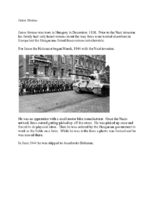
Biographical essay about Janos Strauss, 2014
Date
Archival Collection
Description
Janos Strauss was picked up by the Nazis at age 15, but lied and said he was 17, which saved his life. He was liberated during a transport in 1945.
Text

Transcript of interview with Myra Berkovits by Barbara Tabach, August 21, 2014
Date
Archival Collection
Description
Interview with Myra Berkovits by Barbara Tabach on August 21, 2014. In this interview, Berkovits talks about growing up and starting her teaching career in Chicago. When she moves to Las Vegas, Berkovits eventually purchases a dining concierge business, but returned to teaching, and is now involved with the Sperling Kronberg Mack Holocaust Resource Center.
Myra Berkovits was born Myra Mosse in 1944 in Chicago, Illinois. She became an elementary school teacher in Chicago before moving to Las Vegas in 1980. Myra has made contributions to Las Vegas in the public and private sectors. She owned several businesses then returned to teaching, heading to the University of Nevada, Las Vegas (UNLV) to renew her teaching license and later received her master's degree. After a year of teaching in multicultural education, Myra was then in charge of the school district's homeless program, seeing its growth from serving 1,200 to 6,000 students. Myra's other passion was for Holocaust education and she became one of six interviewers in the city for the Shoah Foundation, documenting survivors' stories. One interviewee, David Berkovits, would later become her husband of fifteen years. Myra's own Holocaust education was aided by powerful trips to Israel and Poland. She used these experiences to develop and lead student-teacher conferences and classroom curriculum for the whole state. Myra still serves at the Education Specialist at the Holocaust Resource Center.
Text
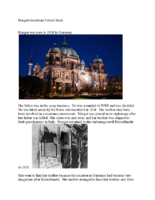
Biographical essay by Margot Goodman, 2014
Date
Archival Collection
Description
Essays describe the early life of Margot Goodman, whose father was killed in the Holocaust. She surivived in hiding and came to the United States in 1941, and was reunited with her mother.
Text
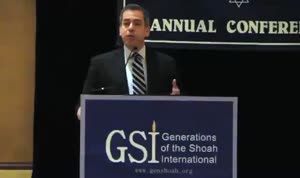
Video, Mark Weitzman presentatation at Generations of the Shoah conference, 2014
Date
Archival Collection
Description
Mark Weitzman discusses the actions to be taken to continue the mission of the Generations of the Shoah organization with Holocaust remembrance and education, and defeating anti-Semitism.
Moving Image
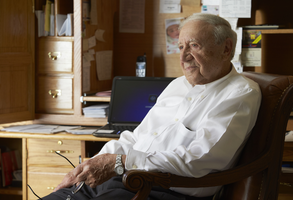
Photograph of Henry Kronberg, Las Vegas, Nevada, May 10, 2016
Date
Archival Collection
Description
Holocaust survivor and longtime Las Vegas businessman Henry Kronberg photographed at his Summerlin neighborhood home.
Image
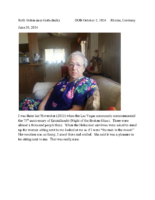
Biographical essay by Ruth Stobin, 2014
Date
Archival Collection
Description
Ruth Stobin (nee Gottschalk) was able to escape Germany in 1939 with the kindertransport to England, and came to the United States in 1941.
Text

Transcript of roundtable interview about Kristallnacht with Esther Finder, Raymonde Fiol, Alexander Kuechel, Philipp Meinecke and Rabbi Felipe Goodman, by Barbara Tabach, March 17, 2015
Date
Archival Collection
Description
In this interview, the participants discuss their experiences during Kristallnacht, and the commemoration events in southern Nevada with Holocaust survivors and their families. Mr. Kuechel recounts his journey through concentration camps and being liberated by the Russians. Rabbi Goodman talks about meeting Mr. Meinecke, whose grandfather was a high-ranking SS officer. Meinecke discusses his upbringing in Germany and trying to learn about his family's involvement in the Holocaust, and the hope he felt after the fall of the Berlin Wall as Jews returned to Germany. The group discusses the importance of Holocaust education because there are still so many untold stories.
On November 9th to November 10th, 1938, in an incident known as Kristallnacht, Nazis in Germany torched synagogues, vandalized Jewish homes, schools and businesses, and killed close to one hundred Jews. In the aftermath of Kristallnacht, also called the Night of Broken Glass, some thirty thousand Jewish men were arrested and sent to Nazi concentration camps. German Jews had been subjected to repressive policies since 1933 when Nazi Party leader Adolph Hitler became chancellor of Germany. However, prior to Kristallnacht these Nazi policies had been primarily nonviolent. However, after Kristallnacht conditions for German Jews grew increasingly worse. During World War II, Hitler and the Nazis implemented their so-called final solution to what they referred to as "the Jewish problem" and carried out the systematic murder of some six million European Jews in what is now commonly known as the Holocaust.
Text
